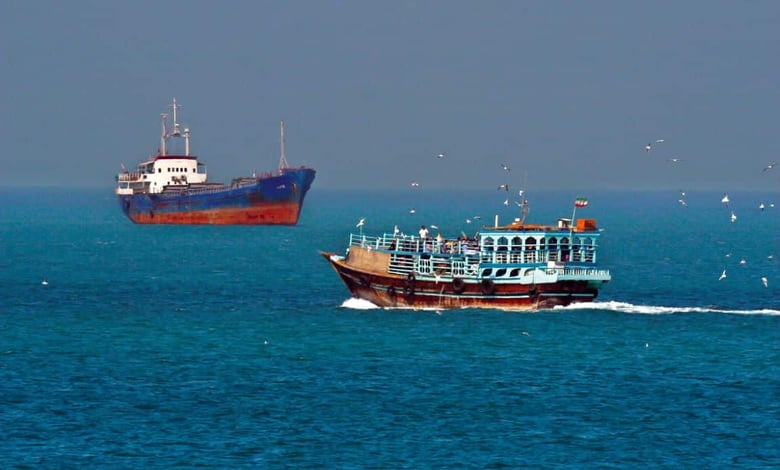The Lenj Boats, a Heritage of the Persian Gulf’s Trade

Whoever travel to the south coast of Iran can’t avoid to notice these massive and beautiful wooden boats, called Lenj. They are found in particular between Bandar Abbas and Chabahar, in the eastern part.
These sailing vessels are a unique heritage of the long sailing and trading tradition of the Persian Gulf. For centuries, men have navigated the sea on these hand-built boats, guided by a knowledge that is now considered as an intangible world heritage by UNESCO.
Contents
The Lenj, an Iranian sailing vessel

Lenj are sailboats equipped with engines instead of sail. They can have an open or semi-open deck, and varies in size and shape depending on whether they are used for cargo or fishing. The name lenj is said to be derived from the English “launch”, and each one of these vessels has its own name; yet, the name is often not written on the boat. What is incredible is that they are, still today, entirely hand-built, following the same process and based on the same knowledge as centuries ago.
Lenj boats have been around in the Persian Gulf, in the Oman Sea and the Indian Ocean for centuries. Their origins dates back to the first half of the 18th century and brings us to the northern coast of the Persian Gulf, in Iran. Originally, the main ports for lenjes were located in the Hormozgan province, in Bandar-e Kong, Bandar-e Lengheh and Bandar-e Laft. In Bandar-e Kong, the construction of lenjes started with the first settlement of people.
These sailing vessels were used for long sea-journey, often of several months long, and the lenjes were said to be able to travel for one full year without requiring important repairs. They were used for trading, but also for fishing and pearl diving. Starting from the south of Iran, they would go to Mumbai, Basra, and Tanzania for trading goods. Lenjes have even been seen in China and in the Mediterranean Sea.
Nowadays, the main ports for lenj boats are Gavaneh, Reeg, Qeshm, Kulghan, Darghahan, Ramchah, Dulab and Guran. Tourists visiting the island of Qeshm can observe workers building lenjes on the Unesco site of Guran.
The construction of Lenj boats

Lenj boats are not only entirely hand-built but they are also built without any plans, only based on the knowledge and experience of the builders. These latter are called “Galaf”. It usually takes a few workers only to build these massive boats, about five or six persons, and the construction lasts about two years, depending on the size.
Building a lenj doesn’t require a lot of materials. Builders first create the boat’s framework with wood before building the body of the vessel. The wood they use traditionally comes from India, and is called “sai” wood. They also use different types of woods, all resistant to moisture, from trees such as jujube, berry tree, plane tree, mesquite, and gum Arabic tree.
To fix the pieces to each other, they use nails and bolts, and they apply pieces of cotton impregnated with coconut and sesame oil between the interstices. This technique is called “kalfat kooby” and is meant to make the boat resistant to water. Yet, once a year at least, the lenj boats require to be repaired as small holes are created on the wood by shells, slowly letting the water coming in.
A UNESCO intangible cultural heritage

In 2011, the UNESCO has inscribed the Iranian skills of “building and sailing Iranian Lenj boats” as an intangible cultural heritage. This is meant to preserve these skills, which are traditionally passed from father to son, and are slowly fading away. Not only the construction skills themselves are considered as an intangible world heritage, but also the whole traditional knowledge around lenjes, both during the construction and the sailing.
That includes the navigation techniques and its terminology. Indeed, there is a very specific knowledge possessed by the captains of these vessels, called Nakhoda, to be able to navigate based on the position of the sun during the day, and of the moon and the stars at night. Furthermore, there is an extended knowledge of weather forecasting, based on the observation of the winds (each of them having their own name), the color of the water, and the height of the waves, that is unique.
Besides navigation skills, the whole folklore and traditions around lenj boats is included in this intangible world heritage. This comprises oral literature about lenjes and trips in the Persian Gulf, as well as festivals performed, for instance, when a lenj boat is for the first time set at the sea. Music also has an important part, as specific songs and rhythms are used both during the construction of the boat by the builders, and during the navigation by the sailormen.
It is all these aspects that the inscription at the UNESCO tends to preserve, as it is gradually disappearing with old knowledgeable people are passing away. Furthermore, wooden lenjes are slowly replaced by fiberglass, a cheaper but weaker material, and most of the construction workshops have been turned into repair shops these recent years.
How sea travels influenced the southern culture

The extensive travels done by lenj boats in the Persian Gulf, the Indian Ocean and the Oman Sea has left an important mark over the culture of the south of Iran, in particular on the Hormozgan province and the islands of Qeshm and Hormuz where most sailors departed from. Men used to leave their household for months, and sometimes years, to travel to other parts of the world.
They would primarily trade wheat, dates, dried fishes, Hormuz salt, and pearls against other goods from India and Africa. When they would come back, they would bring with them teakwood, ivory, and gold. To their wives, they will bring colorful fabrics and clothes from India, that are nowadays inseparable of Hormozgan women outfits.
Food, in this region of Iran, has also been influenced by these sea travels and differs greatly from other regions of Iran. Spices bring from India are part of the mix used locally in south of Iran and known as “bandari”. These exchange also influenced the local dialects spoken in the Hormozgan province, with many words coming from Hindi and Swahili.




